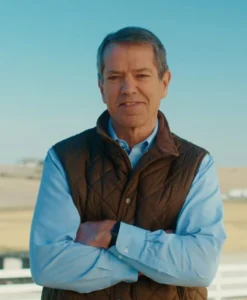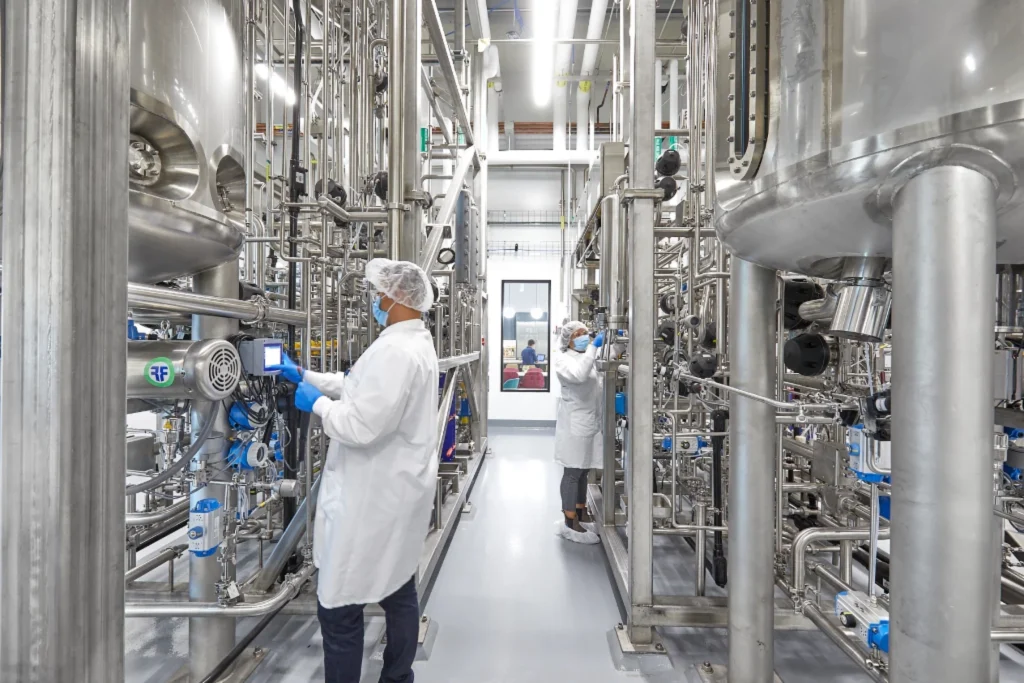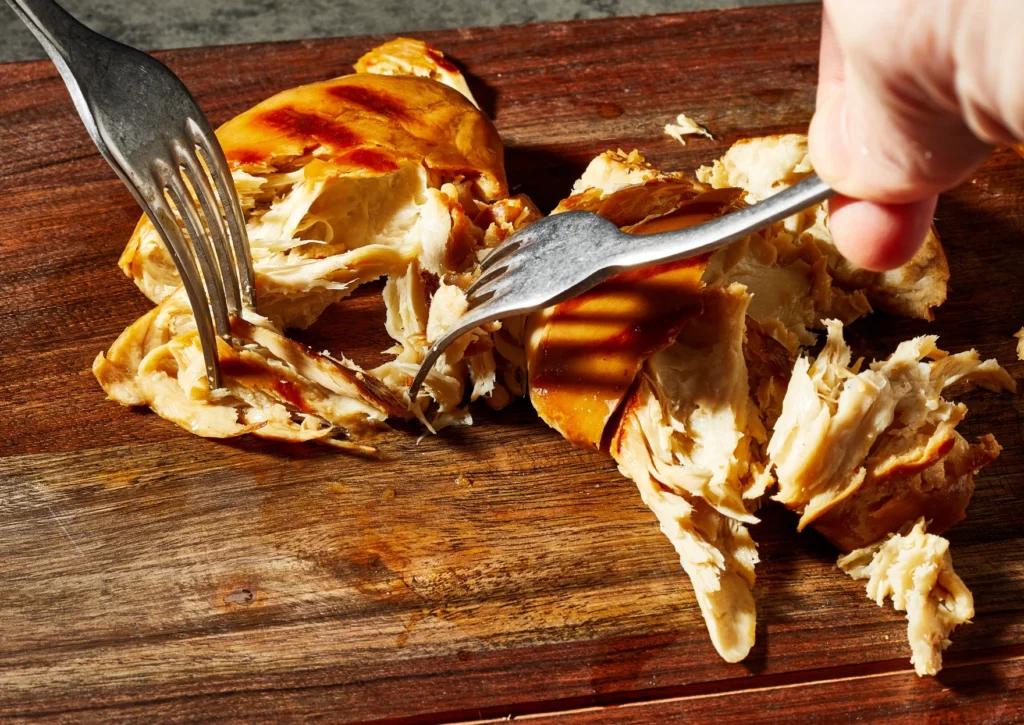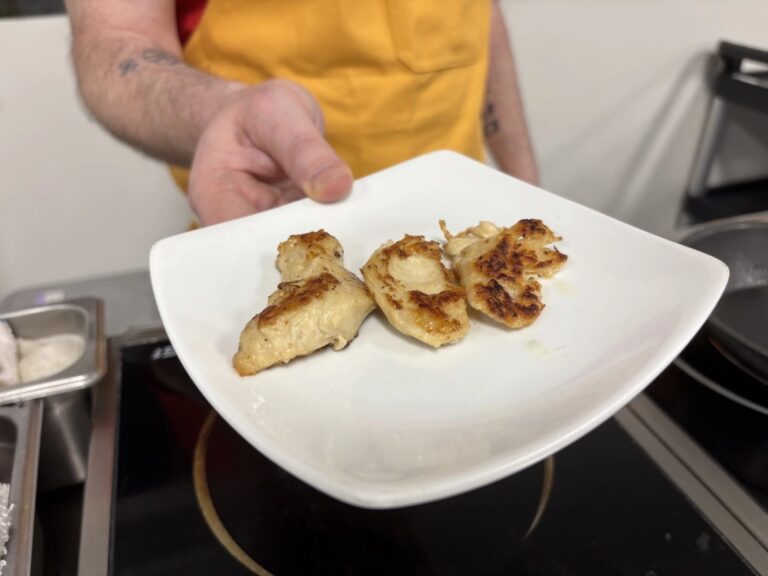Cultivated meat – meat grown from animal cells – is touted as a way to meet growing global demand with far fewer climate impacts. Yet two states banned the sale of cultivated meat earlier this year, and there are proposals in several Midwestern states to do the same.
The meat sizzling in the pan at the GOOD Meat test kitchen looks and smells like chicken.
But this chicken never clucked. Instead, the meat that Sales and Marketing Chief Joshua Hyman is frying up at the company’s headquarters in Alameda, California, came in part from chicken tissue grown from a culture of chicken cells. The rest is plant-based.
“It’s really simple,” says Hyman. “You just cook it like you would cook any normal piece of conventional chicken.“
Yet in some states there’s a growing push to treat this type of meat very differently.
Earlier this year Florida and Alabama passed bans on cultivated meat – or meat grown from cells – while Iowa passed restrictions on its sale and labeling. And bans have been proposed in at least six other states, including Nebraska and Illinois.
Josh Tetrick, GOOD Meat’s CEO and co-founder, calls such bans “political calculus.” He said politicians in some states are trying to make cultivated meat a wedge issue.
“It’s not ideal, that it’s become sort of a cultural thing in those states,” Tetrick said. “But my hope is, as is usually the case, if you make something that most Americans and consumers really want to buy, they’ll do it, and the politicians will adjust.”

New competition
Cultivated meat was first conceptualized in the 1930s, but the production of meat from tissue cultures wasn’t achieved until the 1990s. Now dozens of companies are working toward bringing it to market.
It’s made by taking animal cells from a living animal, fertilized egg or cell bank and placing them inside steel bioreactor tanks, called cultivators. They’re then combined with amino acids, fatty acids, vitamins and other nutrients that cells need to grow.
Two companies – GOOD Meat and Upside Food – received approval in 2023 by the Food and Drug Administration and the U.S. Department of Agriculture to sell their cultivated chicken. The two companies have sold the meat in a handful of restaurants. And since May, GOOD Meat has sold a version of its cultivated chicken product, made by a local partner company, at Huber’s Butchery, an upscale meat shop in Singapore.

But the two companies are years away from reaching a mass market.
Still, Nebraska Gov. Jim Pillen says restrictions need to be established now, before cultivated meat grows to be a real threat to livestock producers.
“Fake meat, petri dish meat, lab-grown meat, bioreactors,” Pillen said, “to just sit back and hope that doesn’t happen? Hope’s not a very good strategic decision.”
Now he’s backing legislation that he hopes lawmakers will take up next year to ban its sale in Nebraska.
“The bottom line is, if a Nebraskan wants to eat the stuff, good for them,” he said. “They’re just not going to buy it in Nebraska.”
In Illinois, State Rep. Chris Miller is sponsoring a bill to ban cultivated meat that’s based on Florida’s new law. Miller raises cattle on his family farm in central Illinois. The Republican lawmaker is critical of tax breaks tied to job creation that Illinois awarded to Upside Foods, when the company announced plans to build a cultivated meat facility in suburban Chicago. (Upside Foods put its plans for the Illinois facility on hold earlier this year.)
“If they want to produce fake meat, then have at it,” says Miller. “But I don’t think it should be subsidized by the taxpayers and by our government, to put them in competition against the ranchers and farmers that are doing a great job of producing protein here in the US.
The company has filed a lawsuit against the Florida ban. On Oct. 11, a federal judge in Tallahassee denied the company’s request for a temporary injunction that would set the ban aside while the case is argued in court.
Scaling up
Proponents of cultivated meat say its advantages are that it can be produced more quickly and has a smaller carbon footprint than meat from the farm. And it doesn’t require the slaughter of animals.
Yet in order to expand its sales beyond the demonstration level, GOOD Meat and other companies must figure out ways to produce cultivated meat in large quantities.
Tetrick said that will require bioreactors that are much bigger and much more expensive than today’s units.
“We want to figure out a way to do it for less than $100 million, less than $150 million,” he said. “And up to this point, we haven’t figured out a way to build that kind of scalable infrastructure for that investment.”
Tetrick expects mass production will become a reality eventually. But he said it will take years, and with a few more years needed to bring prices down to competitive levels.


Some day the cost of cultivated meat could be lower than meat from livestock, according to Professor Thomas Hawke, who studies cultivated meat technology at McMaster University in Hamilton, Ontario, Canada.
But he said he expects traditional meat might keep the edge with quality.
“So the idea is, if you can afford to purchase meat that’s raised in the traditional way, and that’s your choice, that’s great,” Hawke said. “If you can’t … this is an alternative for you.”
Hawke said cultivated meat also could meet the growing global demand for meat in the future without major climate impacts, like clearing land.
“As we think about the type of world we want to live in in the future,” he said, “removing large swaths of the rainforest in an effort to feed people in another country, that becomes problematic as we try to mitigate climate change.”
While the National Cattlemen’s Beef Association, which represents cattle farmers and ranchers, is hardly offering to make room on grocery shelves for cultivated meat, the group is not seeking an all-out ban.
Instead, the association is lobbying for a federal law that would require labeling cultivated meat as “imitation.”
Director of Government Affairs Sigrid Johannes said they’re confident consumers will still choose traditional beef over the cultivated kind, if the packaging makes it clear which is which.
“Our perspective is, give people all the information, make sure that it’s very clear, so that they can make a choice when they go to purchase their groceries for the week,” she said.
Correction: An earlier version of this story incorrectly identified Thomas Hawke as James Hawke. We regret the error.
Dana Cronin contributed reporting for this story.
This story was produced in partnership with Harvest Public Media, a collaboration of public media newsrooms in the Midwest. It reports on food systems, agriculture and rural issues.

